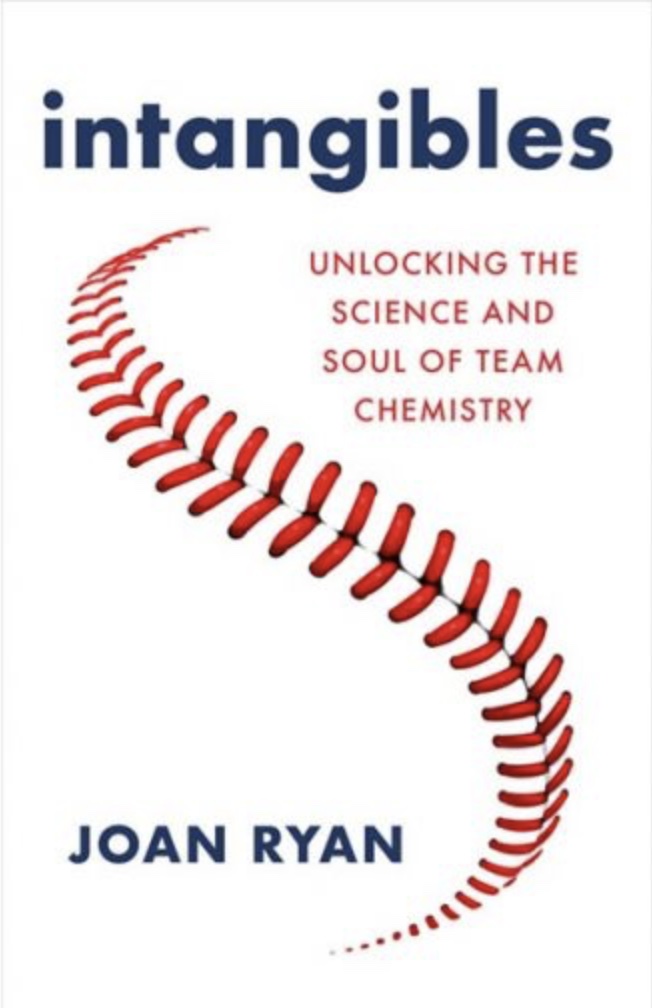Key Quote:
“Archetypes cannot be inserted into a group to create the chemistry. Their emergence is both evidence of chemistry and a fortifier of it, deepening trust and infusing energy” (p. 241).
Key Points and Concepts
Defining Team Chemistry
Team chemistry is defined as “an interplay of physiological, social, and emotional forces that elevates performance” (p. 237).
For teams with great team chemistry, winning is not everything. “Your teammates become the meaning and purpose… there is a sense of completeness” (p. 242).
The Influence of Neurochemicals and Hormones
As humans, we crave connection and belonging. We “possess the ability to have such a profound physiological impact on each other”; therefore, we influence the performance of others around us (p. 8).
Humans release a neuropeptide called oxytocin when we feel a sense of connection or touch another human. Oxytocin is commonly known as the love hormone because it promotes bonding and emotional connections. Male athletes are constantly giving off high fives, chest bumps, and hugs to celebrate successes in their sport. This fosters a united tribe. The response is contagious among the group, forming a stronger bond within the community.
Along with oxytocin, cortisol and testosterone also influence performance. Cortisol, known as the stress hormone, is produced in the body to counteract stress. Cortisol influences testosterone’s impact, creating a series of reactions amongst athletes that lead to good team chemistry. Testosterone “fuels a drive for stature”, where “the environment influences how testosterone expresses itself” (p. 42).
Super-Carriers
Super-Carriers are teammates with grit, passion, and big personalities. They may not have the most skill on the team, but they are attractive to teams because they are infectious people who “chase connection and purpose” instead of status (p. 66).
Jonny Gomes, a left fielder who spent eleven years bouncing around teams in the major leagues, is an incredible example of a Super-Carrier. Gomes grew up in a modest environment, but the sense of belonging was something Gomes felt early on in his life. Once he put on his first baseball jersey and began playing with the kids in town, he noticed how every boy cheered for each other on the team. He loved being part of a team. Once he hit the major leagues, he was an asset and key to the team’s success.
• To Gomes, team chemistry is when people truly care about each other and play for a universal goal.
• Gomes’ energy and attitude were what made him an attractive teammate. When he was playing on the 2013 Boston Red Sox Championship team, teammate Dustin Pedroia said “even on the day he doesn’t play, Johnny’s impacting the game”, bringing toughness, enthusiasm, and insight to the team’s success (p. 56).
Some athletes take on the role of the Super-Carrier later in their careers. Their energy is essential for creating a positive atmosphere within the team. Super-Carriers foster good team chemistry. “The players’ experiences – what they saw, heard, did, felt – are the evidence” of a Super-Carrier’s impact (p. 68).
Super-Disruptors
Super-Disruptors are often cancerous to the team. They isolate themselves from the group, have a bad attitude, and are arrogant athletes who sometimes will force others to adapt to their dynamic. Their impact on team chemistry can be unpredictable.
Super-Disruptors can be exceptional athletes, and, although they have a distasteful reputation, they are essential to the team’s success. They do not look to build relationships, so they do not spread their negativity across the team.
Barry Bonds, listed third in Bleacher Report’s 2010 list of “The 20 Worst Teammates in Sports History”, was a talented baseball player whose demeanor challenged the notion of team chemistry. Although Bonds was not the best teammate, he was crucial to the success of the 1997 Giants. Bonds’ case is complex, as Ryan raises the question of whether a player’s individual success can override the importance of team cohesion and chemistry. He “took [himself] out of the equation and allowed chemistry to define itself among the rest of the players” (p. 89).
The 7 Archetypes of High-Functioning Teams
The Sparkplug: This archetype is often the optimistic, hype man of the group. This athlete “ignite(s) in his teammates a sense of purpose, selflessness, and collective invincibility. That translates into increased confidence and effort, which leads to elevated
performance” (p. 122).
The Sage: This athlete is the wise veteran of the team. With his years of experience, the Sage provides guidance to others and is willing to act as the grandfather of the group.
The Kid: This person is full of energy and reminds the veterans of who they were when they first made it to the big leagues. The Kid is ecstatic to be a part of the team and “carries the dream. She doesn’t know what’s impossible. She believes it’s all there
for the taking” (p. 124).
The Enforcer: To the Enforcer, winning is everything. They are the cautious type, cracking down on teammates when they notice a slippage that could lead to disaster. There are two different enforcers: the Agitator-Enforcer and the Sage-Enforcer. The Agitator-Enforcer often gets eye rolls from his teammates when he calls out a teammate for slacking. The teammates may think he’s a jerk, but at the end of the day, they know he is right. The Sage-Enforcer, on the other hand, has earned the respect of his teammates, is social, and is well-liked. He is emotional and is willing to spend time “listening, counseling and encouraging” other players (p. 126).
The Buddy: This person is friends with everyone. The Buddy is a great listener and genuinely cares about a teammate’s personal life and well-being. They believe that if you feel accepted in the group, this will positively affect performance. He is constantly smiling and laughing at jokes.
The Warrior: This teammate is the greatest of all time. They are exceptional at their sport, fearless, have a winning record, and are the main catalyst to the team’s belief in themselves. His presence creates a confidence boost amongst teammates. Teammates believe that because they have the Warrior on the team, they can win.
The Jester: The Jester is a shape-shifter. He can motivate teammates like Sparkplug, create trusting relationships with others like the Buddy, and crack down on teammates when they are slacking like the Enforcer. To the Jester, laughter eases tension and creates a trusting environment among teammates. “A truly gifted Jester can wield more influence on a team than the strongest Warrior” (p. 131).
Archetype Development and Personality Mixtures
It is important to note that one player can fit into multiple archetypes. For example, the 2016 Chicago Cubs had catcher David Ross as a key component to winning their first World Series in 108 years. Ross was the Buddy and the Sage. As one of the oldest players to play in a World Series, Ross had the experience and wisdom needed to push the team to the World Series Championship. He embraces his age and wisdom, dubbing himself “Grandpa Ross” among teammates and Cubs fans. Along with being the Sage, Ross was a friend to everyone on the 2016 Championship team. Cubs General Manager Theo Epstein said “Rossy was always reaching out to befriend the loneliest players, organizing team dinners, breaking down the barriers that sometimes arise between players of different backgrounds in the clubhouse” (p. 128).
Archetypes may not be established until after the teammate has experienced the other personalities of the team. A teammate might take on one role for one team and a different role for another team. It all depends on the personality dynamics. They need to discover what is required of the team and shift to fill this role. “They don’t know they’re filling a role. They just do it” (p. 137).
“Archetypes cannot be inserted into a group to create the chemistry. Their emergence is both evidence of chemistry and a fortifier of it, deepening trust and infusing energy” (p. 241).
The Power of Leadership, Expectations, and Stressors Affecting Performance
Strong leadership is a catalyst for positive performance, as seen with coach Al Rosen and manager Roger Craig taking over the struggling San Francisco Giants in the 1980s. Rosen set out to eliminate any excuses for failure. Craig called out the players when they did something right, he made every athlete on the team feel important and necessary to success, and he set the expectation that every single player on the Giants was to give 180%. The two turned the struggling franchise into an unforgettable group of talented, cohesive, hard-working athletes.
The Leadership Pyramid: An athlete depends on his coach for guidance. Trust is at the base of the pyramid since trust is the most crucial element for leadership and team success. Adaptability is positioned at the center of the pyramid, but Ryan argues that “you don’t adapt for the sake of adapting; you do it with purpose” (p. 194). Ryan felt there was a deeper layer to adaptability, so she replaced the term with “Understanding and Utilizing Two Fundamental Concepts: The Constancy of Human Nature and the Wild Variability of Actual Humans” as the middle tier. This concept emphasizes that while humans share common needs and tendencies, they express these in infinitely varied ways. Love is at the top of the pyramid. A player needs to feel an emotional connection to their leader. Phil Jackson, a Hall of Fame basketball coach, said love is “the essential ingredient of a championship team” (p. 195).
A team with a culture of high expectations, where every player believes in the success of their teammates can foster an environment that drives everyone to perform at their highest level.
The Pygmalion Effect: Robert Rosenthal studied how expectation affects performance in the 1960s. The research showed that high-expectation children performed better and were more favorable to teachers than low-expectation children. This study translated to the baseball field. Players held to a high standard are encouraged to perform at their best, which can boost the player’s confidence, positively influencing performance.
With success comes enormous amounts of expectations, which can be disastrous to a team. Those who rise to power and see success often lose the attributes that led them to excellence. “Dynasties are rare for a lot of reasons” and success breeds failure (p. 177).
Task chemistry is an athlete doing his job well. The athlete has an outcome in mind, and he does what he can to achieve that goal. This is filtered down throughout the entire team. Everyone wants to win and there is no winning without task chemistry.
One element can change a team’s chemistry. The role of serendipity is crucial to success. “Gather enough right people at the right time with the right leader” and the team’s performance is lifted (p. 241).
Neurologically, stressors bring people together. When a stressor is introduced, the team begins to suffer together, creating opportunities for teammates to bond, grow, and develop a sense of unity. When faced with stressors, teammates rely on each other for emotional and psychological support, ultimately improving performance.
Ryan, J. (2020). Intangibles: Unlocking the Science and Soul of Team Chemistry. New York: Little, Brown and Company.

“Archetypes cannot be inserted into a group to create the chemistry. Their emergence is both evidence of chemistry and a fortifier of it, deepening trust and infusing energy” (p. 241).
“Super-Carriers are teammates with grit, passion, and big personalities. They may not have the most skill on the team, but they are attractive to teams because they are infectious people who “chase connection and purpose” instead of status.”
“The Buddy: This person is friends with everyone. The Buddy is a great listener and genuinely cares about a teammate’s personal life and well-being. They believe that if you feel accepted in the group, this will positively affect performance. He is constantly smiling and laughing at jokes.”
“One element can change a team’s chemistry. The role of serendipity is crucial to success. “Gather enough right people at the right time with the right leader” and the team’s performance is lifted.”
